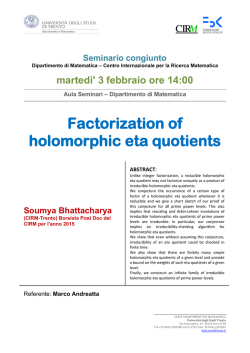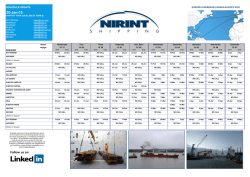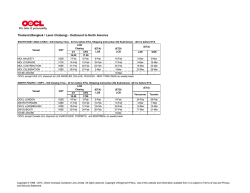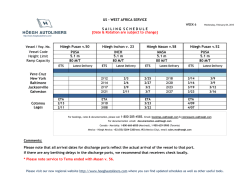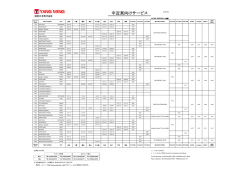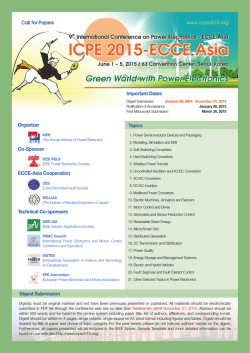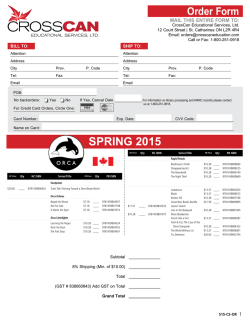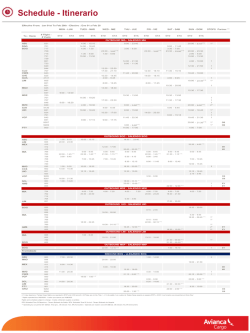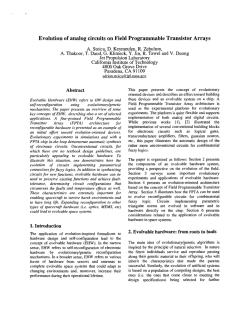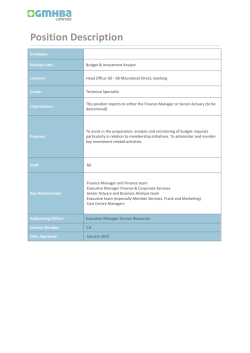
Student Electronics Technician (SET)
Student Electronics Technician (SET) Basic Electronics Competency Requirements For use by high school and post-secondary programs that offer training in basic electronic applications. The SET may be used for program assessment and as student certification from the following topics in these competencies. 1.0 Safety 1.1 1.2 1.3 1.4 1.5 1.6 1.7 1.8 1.9 2.0 Electron Theory 2.1 2.2 2.3 2.4 2.5 2.6 2.7 2.8 3.0 State Ohm’s law and Watt’s power laws List 12 common basic electronic formulas derived from Ohm’s and Watt’s laws State Kirchhoff laws for current and voltage Explain formulas used in series circuits Explain formulas used for parallel circuits Identify circuit configurations of series, parallel and combination circuits Explain the purposes of grounding and common conventions Calculate power consumption, dissipation and energy units Describe capacitance and its units of measure including charging and discharging curves AC Basics 4.1 4.2 4.3 4.4 4.5 4.6 4.7 4.8 5.0 Describe atomic structure and parts of the atom with its electric charges Describe the action of electrons, protons and neutrons Explain static charges and coulombs Explain current flow and units of measure Explain potential difference, voltage drop and units of measure List types of resistive materials and units Describe voltage sources, batteries and electromagnetic force Explain the creation of magnet poles and magnetic effects DC Basics 3.1 3.2 3.3 3.4 3.5 3.6 3.7 3.8 3.9 4.0 Describe electrical shock and its causes List the effects of electric current on the human body Explain shock hazards when working around power sources Identify sources of static charges and its damage to sensitive components 1.4.1 Describe static charge prevention straps, mats and grounding List tools use hazards in the workplace and in the field Describe lockout and tagging rules for unsafe electrical or mechanical hazards Explain where eye and ear protection are needed List safety concerns related to the National Electrical Code Describe the types and usage of fire extinguishers List methods that produce alternating current Describe sine wave shapes and RMS values Describe capacitance and its units of measure Describe magnetic flux and inductance and list its units of measure Explain how series circuits with R, C and L values are used in electronics equipment Explain how inductance relates to magnetism and describe coil construction, cores and usages Compare reactance and resistance and describe current/voltage relationships Compare impedance with reactance and resistance 4.8.1 Explain the causes and effects of impedance Wire and Cables 5.1 5.2 5.3 5.4 5.5 5.6 List wire types, purpose of insulation and construction Explain the American Wire Gauge (AWG) sizes of conductors List common uses for copper cables in electrical and telecommunications applications Explain differences between copper, coaxial and fiber optic cables Explain the effects of proper and improper termination Describe types and testing of splices SET Competencies 1 ® © Copyright 2015, ETA International ® ETA International - Student Electronics Technician (SET) Knowledge Competencies 6.0 Electronic Components 6.1 6.2 6.3 6.4 6.5 6.6 6.7 6.8 7.0 Semiconductors 7.1 7.2 7.3 7.4 7.5 7.6 7.7 7.8 7.9 8.0 Explain P-N junction theory Describe types of diodes Explain Zener diode ratings; describe their usage in regulator circuits Identify PNP and NPN transistors as to type and usage Describe FET, MOSFET and CMOS types of components Identify other semiconductors and symbols and explain their uses Compare thyristors with other semiconductors Identify diacs, triacs and SCRs and explain their operation Identify common types of Integrated Circuit packages and chip cases Power Supplies 8.1 8.2 8.3 8.4 8.5 8.6 8.7 9.0 Identify common electronic symbols of components and connection points Identify types of switches and use in circuits Describe fuses and circuit breakers Explain where passive components are used in circuits Identify resistor values by color code and numerical markings Identify capacitor types, ratings and use in circuits Identify inductive components, core materials and how coil diameter and wire size affect values Identify common types of transformers and explain step-up/step-down in relation to turns ratio Describe types of batteries and common usage including primary, secondary and rechargeable cells Describe how to safely work on and around power supplies Describe the differences between half wave and full wave power supply types Identify components that determine output voltage and power Explain the need for power supply filtering, describe hum, and identify common filter types Explain the reasons for regulation in an electronic power supply Explain why and where fuses and circuit breakers are located in protection circuits Amplifiers and Analog Circuits 9.1 9.2 9.3 9.4 9.5 9.6 9.7 9.8 9.9 9.10 List common amplifier devices List common amplifier configurations Describe the purpose of components in an amplifier circuit List the usages and classes of amplifiers Describe decibel (dB) measurements, voltage and power gain Explain frequency response of an amplifier circuit and why it is important Explain the uses of operational amplifiers and how they differ from discrete amplifiers Identify causes of distortion in amplifiers and list ways to reduce or eliminate it List types of feedback Describe types of oscillator circuits 10.0 Interfacing of Electronics Products 10.1 10.2 10.3 10.4 10.5 10.6 List signal levels in electronics products List anticipated signal or voltage levels for output circuits in audio and video equipment Explain the importance of impedance matching and list causes of mismatches Explain common types of connectors Explain grounding methods Describe power transfer between circuits, components used and problems of mismatch 11.0 Digital Concepts and Circuitry 11.1 11.2 11.3 11.4 Describe the use of binary numbers and math, converting between binary and decimal Identify symbol and function of digital logic gates: (AND, OR, NOT, NAND, NOR, XOR and XNOR) Explain truth tables for basic gates Explain Boolean equations from a truth table for combinational logic circuit 11.4.1 Simplify Boolean equations using Boolean Algebra or K-map 11.5 Simplify combinational logic circuits to the fewest number of chips using NAND or NOR gates 11.6 Explain the purpose of a latch and list common flip-flops 11.7 Explain the purpose of clocks in sequential circuits SET Competencies 2 ® © Copyright 2015, ETA International ® ETA International - Student Electronics Technician (SET) Knowledge Competencies 11.8 List types and functions of shift registers 11.9 Explain how counters and timers operate 12.0 Computer Electronics 12.1 12.2 12.3 12.4 12.5 12.6 12.7 Describe the major components of a computer Describe how the computer block diagram and flow charts are utilized Explain Operating System functions and common types Explain the function of a bus and how it connects the CPU, peripherals, and/or memory devices Describe different types of computer memory and how storage is accomplished List various types of peripherals, USB and other connector usage Describe how microprocessors function and identify internal sections 13.0 Computer Applications 13.1 13.2 13.3 13.4 13.5 13.6 Explain basic computer operation List ways to backup data and the importance of daily back-ups Explain the causes of line surges and viruses and protection procedures against each Explain major components and use of the Internet, browsers and IP addressing List commonly used programming languages List commonly used software application programs 14.0 Audio and Video Systems 14.1 14.2 14.3 14.4 14.5 14.6 Explain major components of common entertainment, function and security products Describe microphone types, construction and usage Explain speaker construction, usage and precautions List the types of cables and connectors used in audio and video applications Describe distorted sound and electronic/acoustical causes of distortion Explain how signals may conflict and the indications the conflict may produce, including interference and static 14.7 Explain how to isolate problems between discrete equipment 15.0 Optical Electronics 15.1 15.2 15.3 15.4 15.5 15.6 15.7 15.8 15.9 Describe symbols for photo resistors, photodiodes and phototransistors List materials that make up optical devices List common display devices and describe how numbers and letters are activated Explain where and how LCD displays are used Describe how LED devices function List applications of opto-isolators Describe uses for light-activated controls and photosensitive devices Explain where charge-coupled devices (CCD) are found List products where lasers are used 16.0 Telecommunications Basics 16.1 16.2 16.3 16.4 16.5 16.6 16.7 16.8 Describe major types of communications: landline, wireless and two-way Explain half duplex and full duplex communications Describe copper and fiber telephone local loop circuits Explain the common connectors, plugs and jacks used in communications List fiber optics types List common RF (Radio Frequency) bands Explain types and frequencies used in cellular communications Describe common wireless schema, such as WiFi, Bluetooth, and Zigbee 17.0 Industrial and Manufacturing Automation 17.1 17.2 17.3 17.4 17.5 17.6 17.7 Identify types of DC motors Describe the common uses of AC motors Identify types of alternator and generator power sources Describe use and types of sensors Explain the use of ladder logic and control devices Explain how microcontrollers and PLCs function Describe the use and programming of major types of control panels SET Competencies 3 ® © Copyright 2015, ETA International ® ETA International - Student Electronics Technician (SET) Knowledge Competencies 18.0 Test Equipment and Measurements 18.1 18.2 18.3 18.4 18.5 18.6 18.7 18.8 Describe how a Digital Multimeter (DMM) and related meters operate Identify meter protection, safety and usage Explain care of equipment and test leads List the purposes and types of signal generators Describe meter loading and precautions observed List the uses and precautions for logic tracer test probes Explain how logic pulsers are used Describe oscilloscope usage and explain the purposes of front panel controls 19.0 Soldering - Desoldering Tools 19.1 19.2 19.3 19.4 19.5 19.6 19.7 19.8 Describe soldering safety Explain hazards of solder fumes and solder spatter Explain solder flux usage and describe types List types of solder and reasons for choosing each Identify cold solder joints and explain causes Describe the differences between good and bad mechanical and electrical solder connections Describe various types of desoldering equipment and how it is used Describe how to use of braid-wick solder removers 20.0 Troubleshooting and Repair Procedures 20.1 Explain the order of the troubleshooting process and techniques to find problems 20.2 Describe how to locate/cross reference parts and products in catalogs and online 20.2.1 Explain how to safely download service and technical information 20.3 Explain the purposes and requirements for proper documentation 20.4 Explain how block diagrams are used for troubleshooting and maintenance of electronics products 20.5 Explain the differences between wiring prints, circuit board views, schematics and block diagrams 20.6 Describe the purpose and use of test points including their likely placement on schematics 20.7 Explain how schematics are used to locate component and wiring failures in electronics products 20.8 Explain the methods of using flow diagrams/charts End of Basic Student Electronics Competencies Listing (with 20 major Categories, 160 Items) Find An ETA Test Site: http://www.eta-i.org/test_sites.html Suggested additional study texts and resources: The Associate CET Study Guide, 6E; ETA International; ISBN 1-891749-07-2; 2012; Available through ETA at 800-288-3824 or www.eta-i.org; $60 EM Study Guide series; Karl Eilers; download through ETA at 800-288-3824 or www.eta-i.org Electronic Principles, 8E; Malvino, Bates; ISBN 978- 0073373881; McGraw Hill; 2015 Electricity & Electronics, 10E;, Gerrish, Dugger & Roberts; ISBN 978-159070-883-5, Goodheart-Wilcox; 2008 Electronics: Principles and Applications, 8E; Schuler; ISBN 978-0077567705; McGraw Hill; 2012 Electricity: Principles and Applications, 8E; Fowler; ISBN 978-0077567620; McGraw Hill, 2012 Digital Electronics: Principles and Applications, 8E; Tokheim; ISBN 978-00733733775; McGraw Hill, 2013 Cabling: The Complete Guide to Copper and Fiber-Optic Networking, 5E; Oliviero & Woodward; ISBN 9781-118-80732-3; Sybex, Inc.; 2014; Available through ETA at 800-288-3824 or www.eta-i.org Review MasteringElectronicsDesign.com website; RMS material; Adrian S. Nastase; 2013 Check online for NEETS module content: www.tpub.com/neets/index.htm ETA certification programs are accredited through the ICAC, complying with the ISO/IEC 17024 standard. SET Competencies 4 ® © Copyright 2015, ETA International
© Copyright 2025
